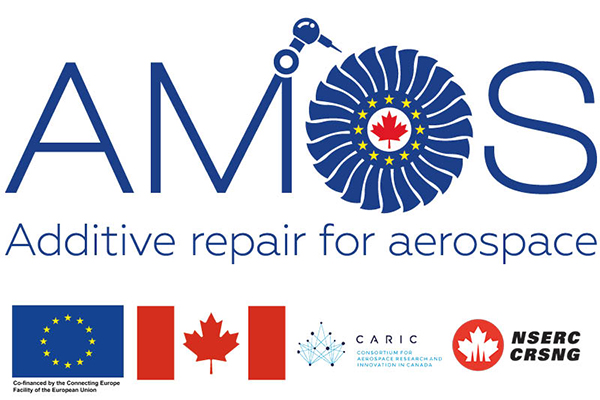The Amos project developed additive techniques for the repair and remanufacture of aerospace components.

The Amos project received funding from the European Union’s Horizon 2020 research and innovation programme under grant agreement No 690608. This project was co-funded by the Canadian funding agencies NSERC and CARIC under grant No. CRDPJ 479630-15.
It was one of the first European-Canadian projects to be funded under the “Mobility for Growth” collaboration in aeronautics R&D.
Background
Additive repair of components such as turbine blades and landing gear would significantly reduce the time and cost of regular maintenance and repair for the aerospace industry, while reducing material waste and extending the life of expensive components.
The Amos project (Additive manufacturing optimisation and simulation platform for repairing and remanufacturing of aerospace components) brought together nine partners from Canada, France, Sweden and the UK, including research organisations, top-tier aerospace manufacturers, and specialist technology developers.
To develop the fundamental tools and knowledge to enable the Amos vision of additive repair, the consortium investigated a range of direct energy deposition techniques which combine welding tools with automated control to accurately deposit and melt metal powder or wire. Many of these techniques are already used in aerospace and other industries to build new parts to near-net shape.
The Amos team researched fundamental aspects of these additive processes, including the material integrity of deposited metal, and the accuracy and limitations of the deposition process.
The consortium also investigated automated techniques to map damaged areas and calculate repair strategies, and looked at how the near-net shape repairs can be effectively machined to a final seamless shape.
They investigated how additive repair techniques can be factored into the design of new components to optimise efficiency over their life cycle, and completed early work to qualify these innovative repair processes to meet the aerospace industry’s regulatory requirements.
Watch the Amos dissemination video for an introduction to the project, and find out why welding with chocolate is a great way to get children excited about engineering.
Partners
The European partners were the University of Sheffield’s Nuclear AMRC in the UK; Ecole Central de Nantes in France; GKN Aerospace Engine Systems, based in Sweden; and DPS, a French SME specialising in process simulation and optimisation.
Canadian partners were McGill University, Montreal; the University of Ottawa; jet engine manufacturer Pratt & Whitney Canada; landing gear supplier Héroux-Devtek; and automated welding specialist Liburdi.
Research focus
The Amos consortium focused on a number of different additive processes and materials to assess their use for repair.
Researchers investigated three aerospace alloys (Ti-6Al-4V, Inconel 718, and AerMet100), in both powder and wire form. These were deposited using a variety of direct energy deposition (DED) systems including lasers or tungsten arc welding.
The partners completed fundamental research to understand the resultant material properties of a number of different DED processes for these three materials, investigating the accuracy and limitations of each.
The research had six core objectives:
- Study the process accuracy, repeatability, limitations and material integrity of different direct energy deposition (DED) systems using selected materials.
- Develop an effective system to generate the repair geometry.
- Develop accurate models to simulate the different deposition processes.
- Develop a repair process planning module.
- Develop a method to optimise component design for additive repair.
- Determine the data necessary for qualification of DED technologies for repair and remanufacture.
The partners developed innovative methods to generate computer models of each unique defect, which can be sent to the additive controller. In conjunction with new sensors developed as part of the project and detailed process models, this will allow repair trajectories and parameters to be generated for each specific component.
The consortium also looked at the overall component design process and optimise commonly damaged parts so that they are suitable for repair using DED processes.
Results
The project delivered:
- A detailed set of material properties (results from tensile tests, low cycle fatigue, fatigue crack growth tests) which forms part of the aerospace qualification route. Find out more about the DED process development and database.
- Software and tools for repair characterisation feeding into deposition process planning.
- A novel method of very accurately measuring melt-pool temperature in situ which can be used to validate process models and simulations.
- Thermo-mechanical models – empirical and simulations of melt-pool, powder stream and part microstructure.
- Process planning modules for each individual system to be used for part repair.
- Design optimisation module which produces a set of optimised designs for objectives of performance, mechanical functionality and ease of manufacture and repair.
- Evaluation of the project work for typical aerospace repairs.
See the Amos publications page for a full list of research papers and publications from the project.



